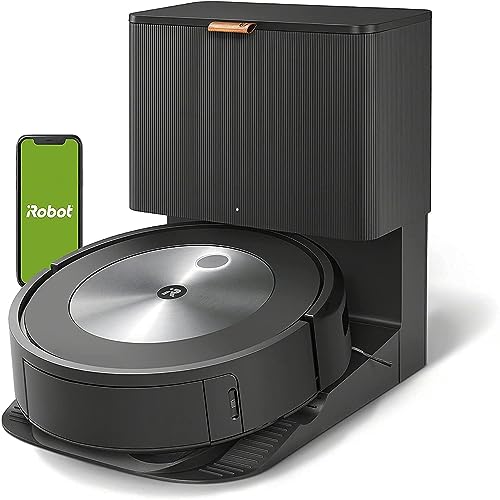10 Top Mobile Apps For Self Emptying Robot Vacuum

Self Emptying Robot Vacuum
A self-emptying robot vacuum is among the best items you can purchase for your home. It is more efficient and hands-free especially for those with larger houses.
The dock of a robot rests on a small container that can be emptied at least every couple of days or more often depending on the model. Self-emptying bases are often large and heavy.
It's more convenient
If you're fed up of emptying your robot vacuum's dustbin after each cleaning cycle, consider splurging on self-emptying models. These bases store dirt in a much larger container, and are usually classified by the number of days (or cleaning sessions) they can hold before you have to empty them, which means that your robot is less likely to reintroduce dust clumps to the air and make allergies worse.
These models are typically more advanced than the standard robot vacuums, making them even more user-friendly. For instance, some models have a map of your home that allows you to label different rooms or designate virtual "no-go" zones for specific areas. Others can return to their base automatically to recharge after the cleaning process, or if the power is exhausted. They could also have a variety of cleaning options, including mop, spot clean and auto-mop. Some provide voice control using Alexa or Google Assistant.
Be prepared for a loud process. If the bin is full, the device will take a few minutes to empty it. This could be disruptive. It is possible to alter the settings to create quieter vacuums however, they will be louder. Certain vacuums come with DND mode, which is useful when you're using the device in your bedroom or in other areas where it could disturb you.
Robot vacuums may also get caught in shoelaces, cords or pet toys. They might even lose track, sending you an SOS for assistance. You'll need to physically put the robot vacuum back into its base in order to reorient it before resuming its cleaning or charging session. It's a little annoying however, but you'd need to do this manually for any other vacuum.
Overall, self-emptying robot vacs provide a lot of convenience and are worth the cost in case you're bored of emptying the robot's trash bin after every cleaning cycle. discover this to keep in mind that these vacuums aren't suitable for all homes. Their dirt capacity is smaller than a standard vacuum, and their base might not be large enough for some households.
It's safer
A robot vacuum might be more advanced than a traditional stick or barrel vacuum, but it still has moving parts and is prone to breakages. As a result, it can be more expensive and is harder to repair than a standard vacuum. In addition, many robot vacuums require more frequent maintenance, like cleaning out the brushes and filters than regular vacs. Some even have extra components like sensors, a computer brain and app integration that make them more complex to use and repair.
The positive side is that a lot of these issues can be solved with the self-emptying robot vacuum. Manufacturers evaluate their products based on the number of days or cleaning sessions worth of dirt that the external canister can hold generally between 30 and 60 days. It is easy to fill up the canister of your robot vacuum if you have to empty it every two weeks. However, if your robot auto empties its canister in a timely manner, it will not only be much more user-friendly and operate, but you will also be able to use it more often.
Many manufacturers also sell additional brush and filter kits, which can be used to replace worn ones. This can extend the life of your robot and help it perform at its best for longer which makes it a more sensible choice than a less basic model. Some brands also provide zoned saving features, which permit you to create no-go areas so that your robot does not accidentally clean certain areas.
Most of these models have a quiet setting, which will make it less likely to be disturbed while the machine is working. This is particularly useful for families with small children or pets. Of course, if you have a smart home or work from home, you can also schedule the robot vacuum to come at times when you're away from home.
It's also less expensive
A standard robot vacuum will only hold a certain amount of dirt before the internal dustbin needs emptying. The dust is thrown back into the air, which could cause sneezing and a rash in homes with allergy-prone families. Self-emptying robot vacs eliminate this problem out of the picture, since they automatically dump dirty dust into a separate bin. The most reliable models can last for months or even years without needing to empty the bin.
These robots are great for busy households, as they can help keep the house clean without having to pause in the middle of something else to empty the base. These robots are particularly helpful in areas with a lot of mess, like the kitchen or living room, where children and pets leave their marks. They're also a good option for older homes that struggle to stay clean.
As more robotic vacuums with self-emptying bases enter the market they're becoming less expensive. Most cost $400 or less. That's a big savings over the The $1,400 you'd pay on a typical robot vacuum. Additionally, these vacuums are far more flexible than traditional models. They can be used in both wet and dry mode, allowing you to use them on dry and sticky spills as well as soiled carpets.
They also can work with apps to schedule cleaning sessions and sync with digital voice assistants, such as Alexa, Google Assistant or Amazon's Echo. This makes them easy to use for people who do not have the patience or time to operate the robot vacuum using the help of a remote.
This technology does not come without its downsides. The main one is that the bases themselves are large and take up a significant amount of floor space. They can also be quite heavy, which can increase the total cost of the device. The process of emptying the device can be noisy and slow.
While self-emptying robot vacuums are an excellent method of reducing time and effort, you'll need to clean other areas of your home frequently. You should also take care to clean up any spills that have gotten wet and clean the sensors and charging contacts on the robot's dock as well as base.
It's greener
The best self emptying robot vacuums are typically more eco-friendly than non-self-emptying counterparts. This is due to the fact that the docking station in the vacuum functions as an internal dustbin that collects dust from cleaning cycles. The bin can be cleaned and replaced with a new one, just like a regular one. The filtering bin helps to catch dust particles that could otherwise be reintroduced into the home's atmosphere which makes these machines an ideal choice for homes with respiratory issues or allergies.
Some self-emptying robotics do have a few drawbacks despite their environmental friendliness. For instance, they can be noisy. The noise is typically louder than the motor of the vacuum, and it can come at random points during a course. This can be distracting if you're working or cooking at the same time.
Self-emptying robots can also be an issue because they take up a large amount of space on your floor. They typically have a huge base which can hold several weeks or months of trash. This can be a problem in small homes and apartments where every inch counts. If you select a model that also mop, the tank is large and will require a larger floor space in order to keep it from spilling out or overflowing.
Self-emptying robots are also more difficult to set up. You'll also have to pick the location of the base that isn't too intrusive. The sensors and charging contacts also need to be cleaned before they can be used. Most of these models also require an initial run, but without cleaning to make an image. Different brands employ different mapping methods, including smart cameras and LIDAR (Light Detection and Ranging), which works similarly to radar.

Overall, a self-emptying robot vacuum is a great investment that will make your life easier. If you are a busy parent, who has to juggle children, work and other chores, being able to turn off the robot and let it take care of itself will be very helpful.
